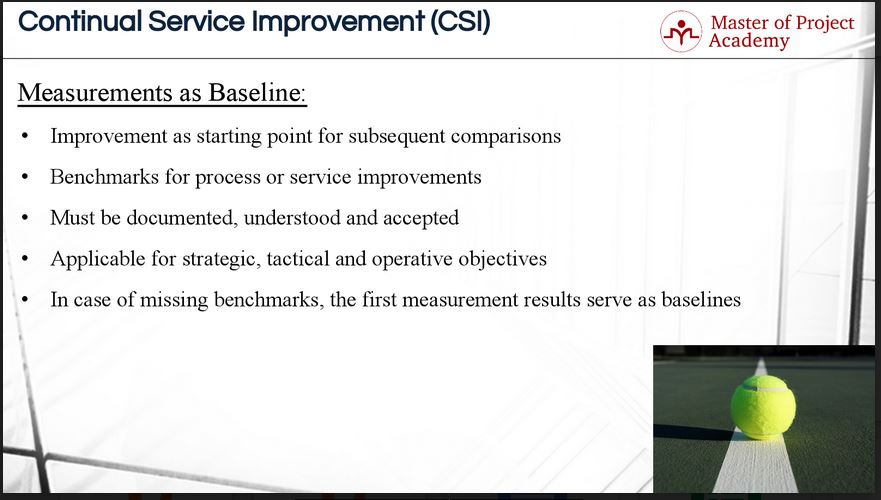During the first four stages of the ITIL service lifecycle, as defined by online ITIL courses, services, and processes of an IT service provider are planned, designed, tested, implemented and deployed into a production environment for the use of the customers or the business. However, these services might not meet the agreed service levels in ITIL Service Operation, or even if the services meet the service levels, there will be always room for better service delivery and improvements. Otherwise, if an IT service provider does not aim to produce better results iteratively, delivered services will be beaten by the competition over time. So this will not be a sustainable business for the IT service provider. Therefore, the Continual Service Improvement stage (ITIL CSI) of the ITIL service lifecycle cooperates with the all other four stages of the ITIL service lifecycle, finds gaps and improvement areas. Then produces service improvement plan to meet a higher and better service delivery to the customer respectively.
Even in some free ITIL courses, we learn that the cornerstone of ITIL CSI is the use of measurements as a baseline. Let’s look at how the ITIL CSI stage uses measurements as a baseline for service improvement.
Measurements as a baseline
A baseline refers to the recorded state of an element at a certain time as a reference value. In the ITIL CSI stage, the baseline is important as a starting point for subsequent comparisons. The main objective of the ITIL CSI stage is getting to a better level in terms of service delivery. In order to compare the results after applying improvement plans, a baseline is taken. Subsequently, improvements in the services and processes are measured to check how far ahead or behind the IT service provider had progressed.
During the ITIL CSI stage, benchmarks for process or service improvements are determined. In the ITIL CSI stage, benchmarks define the expected results after applying the improvement plans. For instance, let’s consider that a service is at the 98.5% availability levels. And after applying some steps, you expect it to reach or exceed 99% availability levels. Here, the expected 99% availability level is the benchmark.
Baselines must be documented, understood and accepted. Later actions, improvements, and plans will be generated over the taken baseline of the IT services and processes.

Baselines are applicable for strategic, tactical and operative objectives. So the baselines are not used only for measuring the current situation of the IT services and processes. Baselines for strategic, tactical and operative objectives are measured as well to be able to make comparisons of these objectives against the baseline in the future.
If there are missing benchmarks, then the first measurement results serve as baselines. In some cases, you might not have the picture of the very first results. But this must not prevent you to improve service delivery. Whenever a first measurement is taken, these first measurements can be used as baseline values and service improvement steps and plans in the ITIL CSI stage can be generated based on these results.
Now that we know how the ITIL CSI process uses measurements as a baseline, we can revisit the objectives and scope ITIL CSI stage.
The objectives and scope of the ITIL CSI stage
ITIL CSI actual covers all other four stages of the service lifecycle: Service Strategy, Service Design, Service Transition and Service Operation. The main purpose of ITIL CSI is, improving the service delivery to customers, increasing value perception of customer and increasing customer satisfaction respectively.
ITIL CSI provides guidance for enabling and conservation of added value. With current resources and capabilities, the CSI stage aims to deliver maximum available output and value for the customers. After identification of improvement areas, actions are taken in order to deliver a better service experience for the customers. The ITIL CSI stage follows principles and methods of quality management when aiming to deliver an improved service delivery.

ITIL CSI ensures continual adjustment and improvement of IT services, taking into account the changing business requirements. While improving the existing status and IT services, business requirements, strategy or vision of the organization can change. CSI must consider these changing business requirements when planning service improvements in the organization.
It verifies, analyzes and recommends improvement opportunities in each phase of the service lifecycle. From ITIL Service Strategy to Service Operation, CSI aims to find improvement points, gaps, and weaknesses and then tries to fill in these gaps and improve weaknesses respectively.
ITIL CSI also evaluates the achieved service quality. If the achieved service quality is lower than the planned value or under the customer’s expectations, then corrective actions should be taken to improve service quality.
When improving service delivery standards, it also aims to improve the profitability of the organization. An organization aims to earn money in the end as a result of investments. That’s why an organization tries to make its customers happier. In this respect, the CSI stage aims to increase the profitability of the organization by improving services and weak points in the service lifecycle.
And finally, it makes sure that appropriate Quality Management methods are applied in the organization. A common quality standard might be adopted by the company such as ISO 9001 or customized quality standards might be determined by the organization. These standards must be followed when delivering services to customers and CSI stage ensures that these quality management practices are applied in the organization.
This article has explored how baseline measurements are used in the ITIL CSI stage of the ITIL lifecycle. It has also reviewed the objectives and scope of the stage and how it fits into the ITIL lifecycle. We now have a thorough understanding of what this stage is all about and how it uses measurement baselines to achieve service improvements.


2 thoughts on “How To Measure Baselines With ITIL CSI?”
Comments are closed.